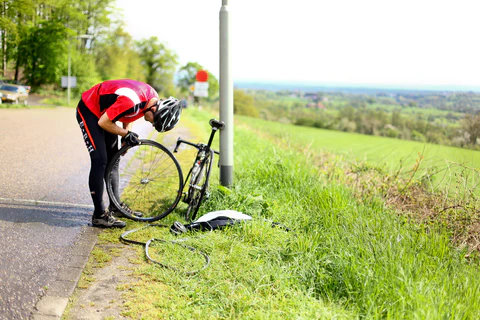Introduction(Fix a Flat Bike Tire on the Road)
Bicycling is a popular and eco-friendly mode of transportation, offering exercise and a sense of freedom. However, encountering a flat tire during your ride can be frustrating and leave you stranded. Knowing how to fix a flat bike tire on the road is essential for every cyclist. In this article, we will guide you through the step-by-step process of repairing a flat tire so you can get back on your bike quickly and continue your journey.

Understanding the Causes of Flat Bike Tires
Flat tires can occur for various reasons, such as sharp objects on the road, improper tire pressure, worn-out tires, or pinch flats. It’s essential to understand the cause to prevent future incidents.
Essential Tools and Materials
Before you embark on a bike ride, carry a few essential tools and materials in case of a flat tire. These include a spare tube, tire levers, a hand pump or CO2 inflator, patches, a multi-tool, and a small towel.
Locating the Flat Tire
When you notice your tire is losing air or is flat, find a safe spot to pull over and inspect your bike. Look for visible punctures, tears, or foreign objects stuck in the tire.
Removing the Wheel
You must remove the wheel from your bike to fix the flat tire. Shift the chain to the smallest chainring and the smallest rear cog. Open the brake calipers, if present, and carefully release the wheel from the frame.
Inspecting the Tire and Tube
After removing the wheel, inspect the tire and tube for sharp objects or punctures. Gently remove the tire from the rim using tire levers, taking care not to damage the tube further.
Finding and Removing the Puncture Object
Locate the puncture by inflating the tube slightly and listening for hissing sounds or feeling for air escaping. Once you find the puncture, remove any debris or foreign objects and ensure the area is clean.
Patching the Tube
Using a patch kit, follow the instructions provided to patch the tube. Apply the patch to the punctured area, ensuring it adheres securely. Wait for the patch to dry before proceeding.
Reinstalling the Tube and Tire
Carefully insert the tube back into the tire, ensuring it is evenly positioned and not pinched. Begin reinstalling the tire onto the rim, starting opposite the valve stem. Use your hands to push the tire back onto the rim, avoiding using tire levers.
Inflating the Tire
Using a hand pump or CO2 inflator, inflate the tire to the recommended pressure. Check the tire’s sidewall for the recommended PSI (pounds per square inch). Avoid overinflating the tire, as it can lead to blowouts.
Checking for Leaks
After inflating the tire, check for leaks by listening for escaping air or submerging the tube in water and looking for bubbles. If there are no leaks, proceed to the next step. Otherwise, repeat the patching process.
Reattaching the Wheel
Align the wheel with the frame dropouts and carefully slide it back into place. Ensure the chain is correctly seated on the cogs and the wheel is securely fastened. Close the brake calipers if they were opened earlier.
Test Riding
Before continuing your ride, test the repaired tire by riding slowly and checking for any unusual vibrations or loss of air pressure. Ensuring the tire is stable, and the repair holds up is crucial.
Preventing Flat Tires
To minimize the risk of future flat tires, consider investing in puncture-resistant tires, maintaining proper tire pressure, avoiding sharp objects on the road, and regularly inspecting your bike for wear and tear.
Read More:
Conclusion(Fix a Flat Bike Tire on the Road)
Experiencing a flat tire during a bike ride doesn’t have to be a daunting experience. Following the step-by-step instructions outlined in this article, you can confidently repair a flat bike tire on the road and return to enjoying your ride. Remember to carry the necessary tools and materials, scrutinize your tire and tube, and practice preventive measures to minimize the risk of future flats. Stay prepared, be patient, and soon you’ll be again pedaling away smoothly.
Frequently Asked Questions
Q: How long does fixing a flat bike tire on the road take?
A: The time required depends on your experience and the complexity of the puncture. With practice, you can fix a flat tire in around 15-30 minutes.
Q: Can I use a temporary fix like tire sealant instead of patching the tube?
A: Tire sealants can temporarily fix small punctures, but it’s recommended to patch the tube properly as soon as possible for a more reliable and long-term solution.
Q: Should I carry a spare tube or patch kit?
A: Carrying a spare tube and a patch kit is advisable. While a spare tube allows for quick replacement, a patch kit can come in handy if you encounter multiple punctures or run out of spare tubes.
Q: Can I repair a tubeless bike tire on the road?
A: Repairing a tubeless tire on the road can be challenging, requiring additional tools and expertise. Carrying a spare tube or considering tubeless tire plugs is recommended for quick fixes.
Q: Are there any preventive measures to avoid flat tires?
A: Yes, you can reduce the likelihood of flat tires by regularly checking and maintaining proper tire pressure, avoiding debris and sharp objects on the road, and using puncture-resistant tires.
